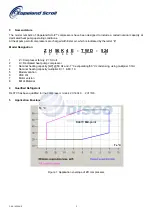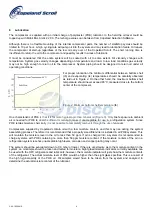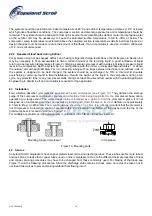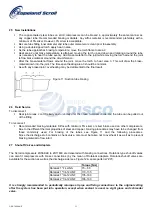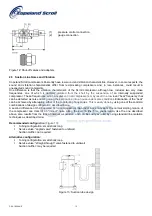
29 Shell
Temperature
Under rare circumstances caused by failure of system components such as the condenser or evaporator fan, or loss
of charge, and depending on the type of expansion control, the top shell and discharge line can briefly but repeatedly
reach temperatures above 177°C as the compressor cycles on its internal protection devices. Care must be taken to
ensure that wiring or other materials, which could be damaged by these temperatures, do not come into contact with
the shell.
30 System Charging Procedure
Rapid charging on only the suction side of a single-phase Scroll equipped system or condensing unit can occasionally
result in a temporary no-start condition for the compressor. The reason for this is that if the flanks of the spirals
happen to be in a sealed position, rapid pressurization of the low side without opposing high side pressure can cause
the spirals to seal axially. As a result, until the pressures eventually equalize, the spirals can be held tightly together,
preventing rotation. The best way to avoid this situation is to charge on both the high and the low side simultaneously
at a rate which does not result in axial loading of the spirals. The maximum charging rate can be determined through
simple tests.
31 Unbrazing System Components
Caution!
Before opening a system, it is important to remove all refrigerants from both the high and low side. If the
refrigerant charge is removed from a scroll-equipped unit by bleeding the high side only, it is possible for the scrolls to
seal preventing pressure equalisation through the compressor. This may leave the low side shell and suction line
tubing pressurised. If a brazing torch is then applied to the low side while the low side shell and suction line contains
pressure, the pressurised refrigerant and oil mixture could ignite when it escapes and contacts the brazing flame. To
prevent this occurrence, it is important to check both the high and low side with manifold gauges before unbrazing.
Instructions should be provided in appropriate product literature and assembly (line repair) areas. If compressor
removal is required, the compressor should be cut out of system rather than unbrazed.
32 Compressor
Replacement
In the case of a motor burn, the majority of contaminated oil will be removed with the compressor. The rest of the oil is
cleaned through use of suction and liquid line filter dryers. A 100% activated alumina suction filter drier is
recommended but must be removed after 72 hours. It is highly recommended that the suction accumulator be
replaced if the system contains one. This is because the accumulator oil return orifice or screen may be plugged with
debris or may become plugged shortly after a compressor failure. This will result in starvation of oil to the replacement
compressor and a second failure.
When a single compressor or tandem is exchanged in the field, a major portion of the oil may still be in the system.
While this may not affect the reliability of the replacement compressor, the extra oil will add to rotor drag and increase
power usage.
See Section for Rotalock valve, flange fittings, sight glass, and mounting bolt torque’s values.
33 Pressure Equipment Directive
All Copeland Scroll compressors covered in this guideline conform to the European Pressure Equipment directive.
The nameplate shows the PED marking CE 0062 with the refrigerant group and low side temperature.
C6.2.16/1004/E 13




